MARIANI’SVirtual
Gourmet
August
4 , 2013
NEWSLETTER
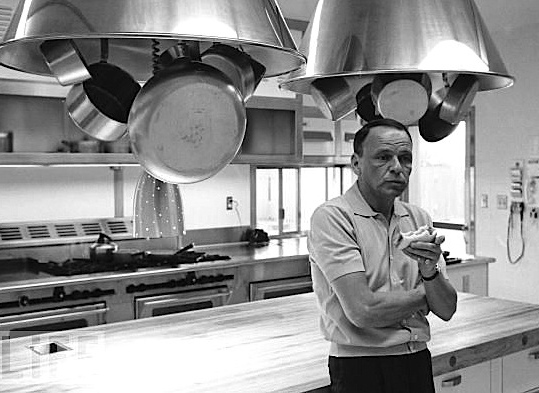
❖❖❖
THIS WEEK
IS MODERNIST CUISINE PASSÉ?
by
John Mariani
NEW YORK CORNER
The Elm
by John Mariani
❖❖❖
IS
MODERNIST CUISINE PASSÉ?
by
John Mariani

Now
celebrating its tenth anniversary, Chef
José Andrés’ 17-seat molecular
cuisine minibar
in Washington, DC, has received every award
possible. His
restaurant Bazaaar
in L.A. was Esquire’s
Best New Restaurant of 2009. Last
year, chef José Andres was named by Time as
one of the 100 most influential people in the
world. This year, Pres. and Mrs. Obama celebrated
Valentine’s Day there. With all that success,
you’d think that the molecular cuisine
Andrés is selling would take the nation’s
capital, and the rest of the nation, by storm. But the
fact is, despite tremendous media hype -- not
least the specious 2013 San Pellegrino Awards that
ranked six restaurants specializing in molecular
gastronomy in their top ten -- the expansion and
influence of that avant garde cuisine has been
next to zero.
Especially in the U.S., the
molecular/modernist (M&M) movement has barely
budged beyond its first breakthrough in 2003
at Wylie Dufresne’s wd-50 in New York and in 2005 at
Grant Achatz’s Alinea
in Chicago. The rest of the molecular restaurants
in the U.S. can be numbered on the fingers of two
hands: Schwa,
Moto, and Grace, all in Chicago; Atelier Crenn
and Coi in
San Francisco; The
Pass in Houston; Catbird Seat in
Nashville, and one or two more that are struggling
to stay open. In New York, Atera, Eleven Madison
Park, and Chef’s Table are using minimal
modernist techniques. Not much to show after ten
years of evolution and hype.
in 2003
at Wylie Dufresne’s wd-50 in New York and in 2005 at
Grant Achatz’s Alinea
in Chicago. The rest of the molecular restaurants
in the U.S. can be numbered on the fingers of two
hands: Schwa,
Moto, and Grace, all in Chicago; Atelier Crenn
and Coi in
San Francisco; The
Pass in Houston; Catbird Seat in
Nashville, and one or two more that are struggling
to stay open. In New York, Atera, Eleven Madison
Park, and Chef’s Table are using minimal
modernist techniques. Not much to show after ten
years of evolution and hype.
Two decades after Ferran
Adrià mightily coaxed foam from carrots at
El Bulli in the Catalonian mountains, his
restaurant has been closed for three years and his
modernist razzle-dazzlements are few and far
between in American restaurants: smoldering
cinnamon sticks (Alinea); hay-infused yogurt with
chamomile and puffed rice (Catbird Seat); edible
menus (Moto); smoked banana pudding (Grace); or
oysters with liquid nitro pearls of smoked
sturgeon set on top of rocks (Atelier Crenn).
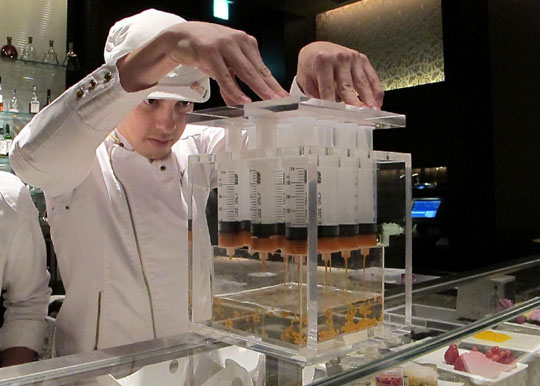 Yes, some of
them fill their tables most
nights they’re open, but if you tallied up all the
seats at all
those restaurants, you’d have fewer than one
night’s seating at any branch of Smith &
Wollensky’s.
Yes, some of
them fill their tables most
nights they’re open, but if you tallied up all the
seats at all
those restaurants, you’d have fewer than one
night’s seating at any branch of Smith &
Wollensky’s.
The irony is that so many
avowed modernist chefs have pretty much gone in
other, more traditional directions. One of the
pioneers, Heston Blumenthal of the Fat Duck in
Bray, England (who hates the term “molecular”) is
now doing updated dishes from British history at
his new London restaurant named Dinner, like
frumenty and salamugundy. Achatz opened Next,
a restaurant doing seasonal turns on global
themes, like “The Hunt,” “Childhood,” and “Paris:
1906,” as well as a homage to El Bulli.
And when Vegas came calling for
ideas from Andrés, he didn’t dispatch the
minibar team there. Instead, he opened Jaleo, a
traditional tapas restaurant, and China Poblano,
a Chinese-Latino eatery. (He did, however, install
a tiny version of minibar there called e.)
Aside from a few
media ever in search of the new, the general
public has shown no particular interest in M&M
cuisine. Young, food-obsessed hipsters--who
get positively pirhanic for everything from bone
marrow to Cronuts--never really took to M&M
gastronomy because of the exorbitant price tag.
And home chefs have been  hard-pressed
to adopt the cuisine because it is so
time-consuming and difficult.
hard-pressed
to adopt the cuisine because it is so
time-consuming and difficult.
I’d estimate that 99 percent of
America’s finest chefs admire the innovations of
molecular gastronomy, and many have probably
bought the six-volume,
$625 book Modernist Cuisine by Nathan
Myhrvold hailed as a culinary landmark. But
they have ignored all the liquid nitro machines,
syringes and centrifuges required. Not a
few have called modernism out as a passing fad.
They are too busy reconceiving more traditional
culinary genres that will happily appeal to most
people: Chef Michael White (Marea, Ai Fiori)
has just opened an Italian steakhouse called Crostata and a
Wisconsin-inspired supper club named The Butterfly in
New York; Ming Tsai (Blue Ginger) has opened an Asian
gastropub named Blue
Dragon in Boston; Mike
Lata (Fig)
debuted a Southern seafood house called The Ordinary
in Charleston; Ford Fry (The Optimist) is doing down-home
American at King
& Duke in Atlanta; Stephan Pyles (Stephan Pyles)
is focusing on Texas cookery at Stampede 66 in
Dallas; and
Michael Cimarusti (Providence) is
doing a seafood shack in L.A. called Connie & Ted’s.
None is doing modernist cuisine.
And where on the horizon is the
next minibar? If you know of any, clue me in. Just
don’t invest in one: most lose money: El Bulli
lost millions. As someone who has, over four
decades, seen culinary fads come and go and
“revolutionary” concepts crash and burn, I don’t
think M&M restaurants are where the smart
money is going.
❖❖❖
by John Mariani
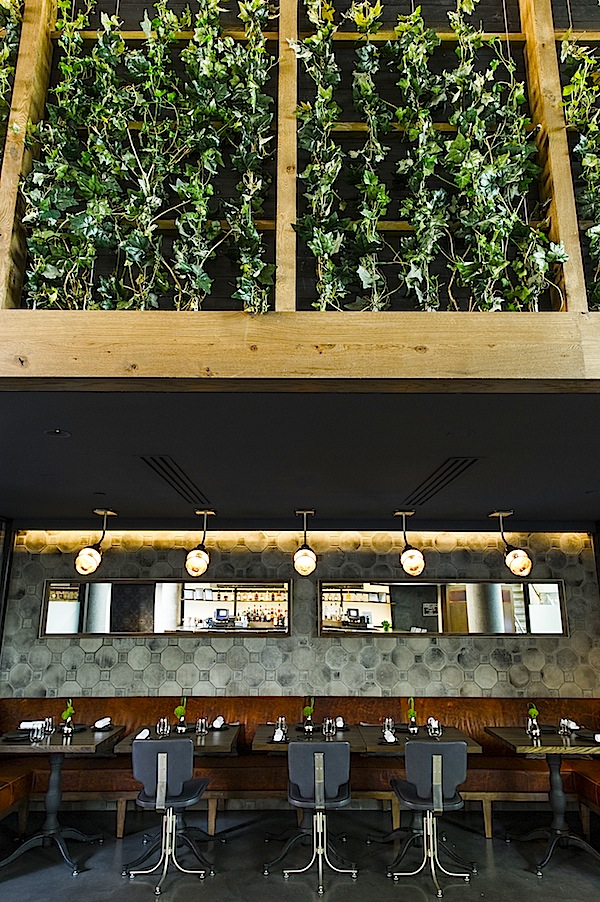 The Elm
The ElmKing & Grove Hotel
160 West 12th Street
Brooklyn
718-218-1088
elm-restaurant
The
rabid praise of Brooklyn restaurants opened in the
past three years may be due more to local pride than
to true excellence, despite a few places that are as
good as the better restaurants in Manhattan.
Many others were so over-hyped that the
so-called “Brooklynization” of dining out, more a
warm breeze than
a strong gust, engendered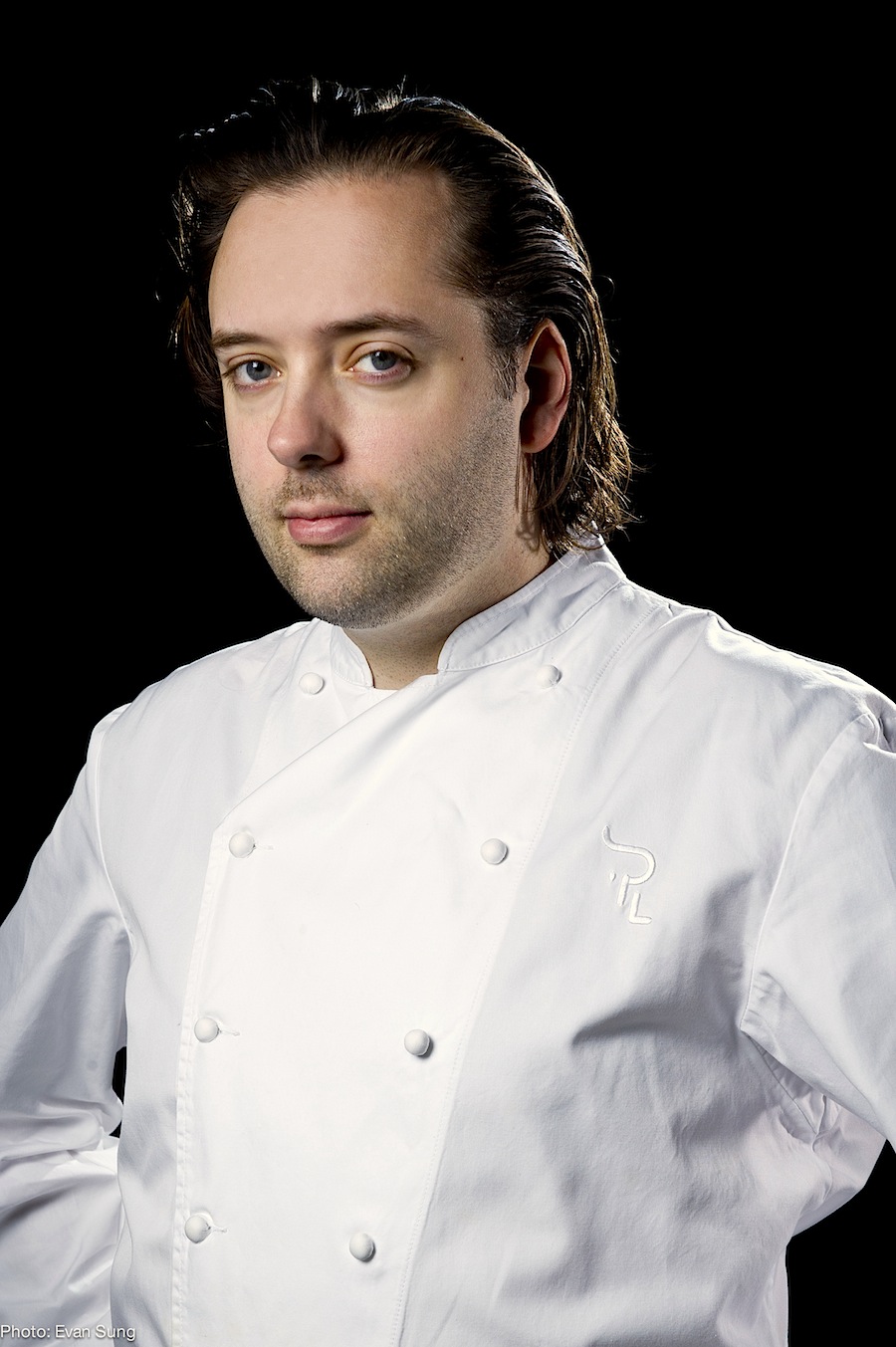 a backlash.
a backlash.
But, with the arrival
of Britain-born Chef Paul Liebrandt (right) in
Williamsburg, expectations were high, and, after
dining at his new restaurant, The Elm, I feel they
have been more than met. Liebrandt brings to
Brooklyn a refinement few others have registered and
a sensibility focused on the cooking, not on an
expression of ego that demands guests eat 20 dishes
of the chef’s choosing in monastic dining rooms
where the discussion of the food becomes positively
obsessive.
Indeed, The Elm, set below ground level, across from
McCarren Park, is a space easy to love, neither
fussy nor stripped to its concrete bare bones, with
greenery, very comfortable seating, and an open
kitchen. The sound level is positively buoyant, and
the staff exhibits none of that hauteur which in
Brooklyn passes for hipster “seriousness.”
Those familiar with Liebrandt’s work in the past
will see how far he has evolved since the days at
Atlas, when the more provocative the dish was, he
thought the better. He later told me that the
eccentricity of his cooking then was due to his
lawyer telling him that to stay in America, he had
to do things in the kitchen no other chef in NYC was
even thinking. The results were … odd. But the
ruse worked.
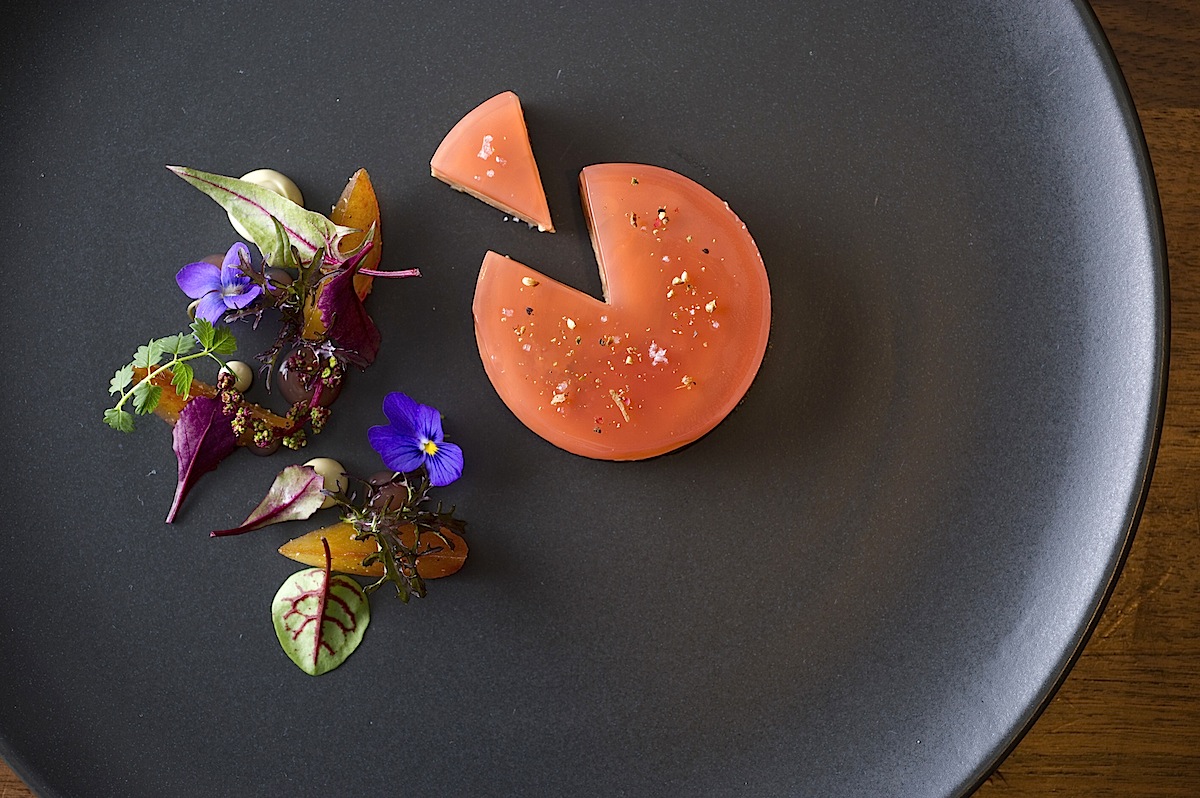 Later
on Liebrandt continued with feats of sensationalism,
as when he held dinners in the dark. So it
stirred tongue-wagging when, five years ago, veteran
restaurateur Drew Nieporent, feeling his
TriBeCa fine dining destination named Montrachet in
need of a shake-up, hired Liebrandt and re-named it
Corton, which, within a year, won just about every
star he could scoop up from the critics, including
two Michelin stars and inclusion in Esquire's Best
New Restaurants of the Year..
Later
on Liebrandt continued with feats of sensationalism,
as when he held dinners in the dark. So it
stirred tongue-wagging when, five years ago, veteran
restaurateur Drew Nieporent, feeling his
TriBeCa fine dining destination named Montrachet in
need of a shake-up, hired Liebrandt and re-named it
Corton, which, within a year, won just about every
star he could scoop up from the critics, including
two Michelin stars and inclusion in Esquire's Best
New Restaurants of the Year..
Sadly, the word was confirmed this week that
Liebrandt has parted with Nieporent at Corton (which
is currently closed). Liebrandt also announced he
would be opening a deluxe restaurant in Manhattan
next year. So, out on his own at The Elm,
within the bosom of the new King & Grove Hotel.
Here he has streamlined his cooking, which was
very complex at Corton, setting it up with four
categories: RAW, SEA, LAND, and SHARE, the last
meant for two people ($48-$56), with most other
dishes costing about $20.
You might
begin with a circular slab of rich, silky foie gras
with a spiced strawberry gelée (left), tiny
pickled strawberries and ginger. Gnudi, the
naked pasta of the moment, is here topped with a
gently seared scallop and flavored with spring
onions and lemon balm, while hand-made agnolotti are
packed with Swiss chard and cuddled in chunks of
lobster, corn and shishito pepper. There are
Mediterranean notes to his Elysian Fields lamb with
charred sweet eggplant and a subtle spicing of ras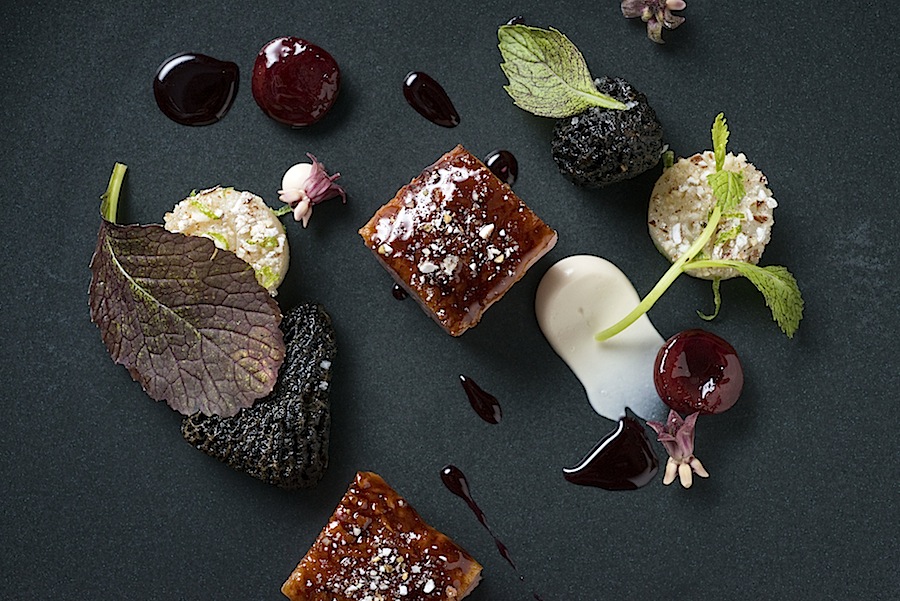 el hanout.
el hanout.
Of
the items for two, we tried the chicken “Kiev
style,” which is a cylindrical, breaded breast of
chicken that explodes with clarified butter when
sliced open. It has a large “wow” factor and
is absolutely delicious.
The summer garden of vegetables,
also for two, is about nothing more than the
perfection of summer vegetables and fruits served en cocotte.
Desserts
follow the same style of restrained elegance, very
British really. The Eton Mess is a mélange of
strawberry, violet crème and brown butter,
which you can imagine might well be served at
Windsor Castle, while the milk chocolate palet with
lemon verbena, hazelnut and malted milk sorbet has a
more international flavor. There is also
cheese—a single kind—offered.
I for one have always dreaded the
trek to Brooklyn for a meal that so easily might
lack the kind of substance shown at The Elm.
In fact, I made the drive from Westchester
County that night in record time –30 minutes--and
the subway stops near The Elm’s door. Add to that,
the gentrified charms of the surrounding
neighborhood—not always the case in the past—and you
have every reason to go out there to dine at the top
of the form in that borough.
The Elm
is open for breakfast and dinner daily. Dinner
small plates run $15-$27, larger courses $20-$56
(for two people).
❖❖❖
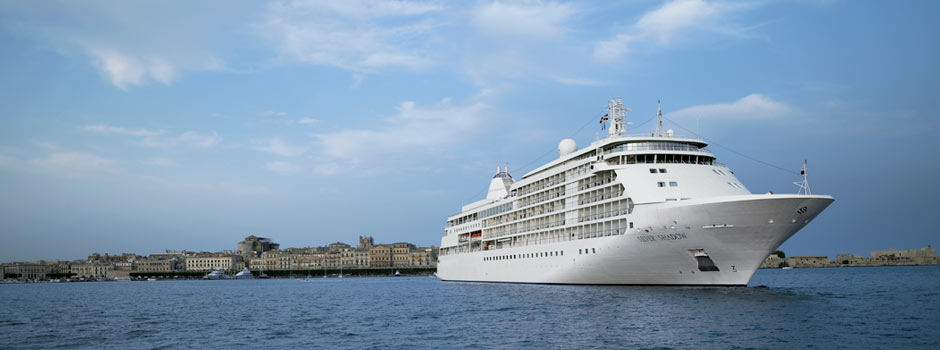
According
to CNN, The Center for Disease Control gave
Silversea Cruises, whose passengers pay $5000 a
week, a failing grade for improperly storing
food in crew member cabins on its Silver Shadow
(right)
luxury liner, citing the ship for "repeatedly for
using an 'organized effort' to remove 15 trolleys of
food from the ship's galley to individual crew cabins
to 'avoid inspection.'" The CDC inspectors then
poured chlorine over the improperly stored food.
 BLOCK
THAT SIMILE!
BLOCK
THAT SIMILE!
“You might curl your lip at the cutesy lingo, but
there’s no quarreling with the cuisine. That
neighbor’s quail? It arrived as bronzed and beautiful
as Cleopatra, plump with kale and apricot
stuffing.”—Josh Sens “Pt. Reyes Pastoral,” San Francisco
Magazine (6/14/13
❖❖❖
Any of John Mariani's
books below may be ordered from amazon.com.
 |
My latest book, which just won the prize for best book from International Gourmand, written with Jim Heimann and Steven Heller, Menu Design in America, 1850-1985 (Taschen Books), has just appeared, with nearly 1,000 beautiful, historic, hilarious, sometimes shocking menus dating back to before the Civil War and going through the Gilded Age, the Jazz Age, the Depression, the nightclub era of the 1930s and 1940s, the Space Age era, and the age when menus were a form of advertising in innovative explosions of color and modern design. The book is a chronicle of changing tastes and mores and says as much about America as about its food and drink.
“Luxuriating vicariously in the pleasures of this book. . . you can’t help but become hungry. . .for the food of course, but also for something more: the bygone days of our country’s splendidly rich and complex past. Epicureans of both good food and artful design will do well to make it their coffee table’s main course.”—Chip Kidd, Wall Street Journal.
“[The menus] reflect the amazing craftsmanship that many restaurants applied to their bills of fare, and suggest that today’s restaurateurs could learn a lot from their predecessors.”—Rebecca Marx, The Village Voice. |
"Eating Italian will never be the same after reading John Mariani's entertaining and savory gastronomical history of the cuisine of Italy and how it won over appetites worldwide. . . . This book is such a tasteful narrative that it will literally make you hungry for Italian food and arouse your appetite for gastronomical history."--Don Oldenburg, USA Today. "Italian
restaurants--some good, some glitzy--far
outnumber their French rivals. Many of
these establishments are zestfully described
in How Italian Food Conquered the World, an
entertaining and fact-filled chronicle by
food-and-wine correspondent John F.
Mariani."--Aram Bakshian Jr., Wall Street
Journal.
"Equal parts
history, sociology, gastronomy, and just
plain fun, How Italian Food Conquered the
World tells the captivating and delicious
story of the (let's face it) everybody's
favorite cuisine with clarity, verve and
more than one surprise."--Colman Andrews,
editorial director of The Daily
Meal.com. "A fantastic and fascinating
read, covering everything from the influence
of Venice's spice trade to the impact of
Italian immigrants in America and the
evolution of alta cucina. This book will
serve as a terrific resource to anyone
interested in the real story of Italian
food."--Mary Ann Esposito, host of PBS-TV's
Ciao
Italia. "John Mariani has written the
definitive history of how Italians won their
way into our hearts, minds, and
stomachs. It's a story of pleasure over
pomp and taste over technique."--Danny Meyer,
owner of NYC restaurants Union Square Cafe,
Gotham Bar & Grill, The Modern, and
Maialino.
|
 |
 |
 |
 |
 |
 |
 |
 |
 Everett Potter's Travel Report:
Everett Potter's Travel Report: 
 Eating Las Vegas
is the new on-line site for Virtual Gourmet
contributor John A. Curtas., who since 1995
has been commenting on the Las Vegas food
scene and reviewing restaurants for Nevada
Public Radio. He is also the
restaurant critic for KLAS TV, Channel 8 in
Las Vegas, and his past reviews can be
accessed at KNPR.org.
Click on the logo below to go directly to
his site.
Eating Las Vegas
is the new on-line site for Virtual Gourmet
contributor John A. Curtas., who since 1995
has been commenting on the Las Vegas food
scene and reviewing restaurants for Nevada
Public Radio. He is also the
restaurant critic for KLAS TV, Channel 8 in
Las Vegas, and his past reviews can be
accessed at KNPR.org.
Click on the logo below to go directly to
his site.

Tennis Resorts Online: A Critical Guide to the World's Best Tennis Resorts and Tennis Camps, published by ROGER COX, who has spent more than two decades writing about tennis travel, including a 17-year stretch for Tennis magazine. He has also written for Arthur Frommer's Budget Travel, New York Magazine, Travel & Leisure, Esquire, Money, USTA Magazine, Men's Journal, and The Robb Report. He has authored two books-The World's Best Tennis Vacations (Stephen Greene Press/Viking Penguin, 1990) and The Best Places to Stay in the Rockies (Houghton Mifflin, 1992 & 1994), and the Melbourne (Australia) chapter to the Wall Street Journal Business Guide to Cities of the Pacific Rim (Fodor's Travel Guides, 1991).


MARIANI'S VIRTUAL GOURMET
NEWSLETTER is published weekly. Editor/Publisher: John
Mariani.
Contributing Writers: Christopher Mariani, Robert Mariani,
John A. Curtas, Edward Brivio, Mort Hochstein,
Suzanne Wright, and Brian Freedman. Contributing
Photographers: Galina Stepanoff-Dargery,
Bobby Pirillo. Technical Advisor: Gerry McLoughlin.
© copyright John Mariani 2013
